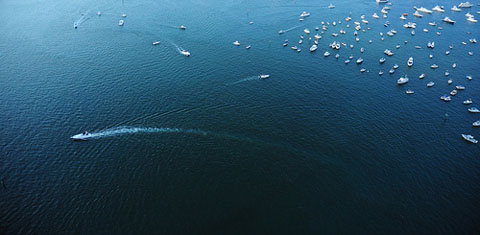Government Cut, Miami. Photograph by Emilio Labrador, posted at Flickr under a Creative Commons license
What is the Caribbean? is not an unanswerable question. But there isn’t — will never be — a single, definitive answer that can encompass the complications of the geographic region named for the Caribs of half a millennium ago, its history and its culture. So our writers, artists, and thinkers keep asking: keep collecting and analysing evidence, outlining and testing theories, devising and deploying a language of criticism and imagination.
One of these thinkers — a man who was not born in the Caribbean, but who has spent six decades working in and on this region — is the eminent anthropologist Sidney Mintz, best known for his book Sweetness and Power (1985), which “describ[es] the economic, historical, and nutritional role of sugar in transforming European peasant societies into a proletariat, and fuelling the Industrial Revolution.” That summary is by Nicolette Bethel, who this week reviews Mintz’s latest book, Three Ancient Colonies, in the CRB.
Based on a series of lectures delivered at Harvard in 2003, Three Ancient Colonies presents case studies of Jamaica, Haiti, and Puerto Rico derived from Mintz’s long-term fieldwork. “Using anthropology’s methods of teasing out universals from variations in human social structure and culture,” Bethel writes, “he lays out a template for thinking about the Caribbean in general” and offers a revisioning of the concept of creolisation, the complex centuries-long socio-cultural process by which the various peoples who would eventually become “Caribbean” adapted to this crucial corner of the New World.
. . . understanding this process may illuminate our consideration of all the anomalous societies of the region, whether they be the seafaring, commerce-centred archipelagos on the periphery of the Caribbean proper (Bermuda, the Bahamas, the Turks and Caicos, the Cayman Islands) or the less slavery-centric Hispanic societies.
If places like the Bahamas and the Caymans are atypical of but at the same time integral to the Caribbean experience, what about a place like Miami? Near the tip of a peninsula thrusting south towards the Caribbean, Miami is closer to Nassau and Havana than it is to Tallahassee, the Florida state capital. Tens of thousands of its citizens are Caribbean-born or -descended, with roots in Cuba, Haiti, Jamaica, Trinidad — the whole archipelago. In “Sweet grouper throats”, an essay-cum-poem also published this week in the CRB, Mark Dow gives us oblique glimpses of contemporary Miami as a city whose bloodlines are at least partly Caribbean:
In the alley between Euclid and Meridian, connecting 14th Street to 14th Place, I ran into my neighbour’s cousin who had made the trip from Havana on an inner tube and would be driving my old blue Cavalier wagon when the Miami Police confiscated it because he was soliciting a prostitute in it, allegedly. We were shirtless and talked about baseball. When he was a boy in Cuba, he said, without a real ball, he and his friends would put two bottle caps back-to-back and wind tape around and around them. When eventually he played with a regulation-size ball, it seemed gigantic and was easy to make contact with. His cousin came over. Yeah, we used to play with a cork. It would dip and curve all over the place, so when we played with a regular, round ball that travelled straight, it was so easy to hit.





